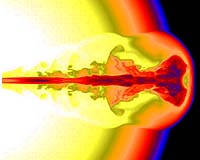 Cosmological Gamma-Ray Bursts and Hypernovae Conclusively Linked
Cosmological Gamma-Ray Bursts and Hypernovae Conclusively Linked

This image is from a computer simulation of the beginning of a gamma-ray burst. Here we see the jet 9 seconds after its creation at the center of a Wolf Rayet star by the newly formed, accreting black hole within. The jet is now just erupting through the surface of the Wolf Rayet star, which has a radius comparable to that of the sun. Blue represents regions of low mass concentration, red is denser, and yellow denser still. Note the blue and red striations behind the head of the jet. These are bounded by internal shocks.
The jet passed through the outer shell of the star and, in conjunction with vigorous winds of newly forged radioactive nickel-56 blowing off the disk inside, shattered the star. This shattering represents the supernova event. Meanwhile, collisions among pieces of the jet moving at different velocities, all very close to light speed, created the gamma-ray burst. This "collapsar" model, introduced by Woosley in 1993, best explains the observation of GRB 030329, as opposed to the "supranova" and "merging neutron star" models.
Detailed supporting images and movies
More at ESO |
Washington - Jun 22, 2003
A very bright burst of gamma-rays was observed on March 29, 2003 by NASA's High Energy Transient Explorer (HETE-II), in a sky region within the constellation Leo. Within 90 min, a new, very bright light source (the "optical afterglow") was detected in the same direction by means of a 40-inch telescope at the Siding Spring Observatory (Australia) and also in Japan. The gamma-ray burst was designated GRB 030329, according to the date.
And within 24 hours, a first, very detailed spectrum of this new object was obtained by the UVES high-dispersion spectrograph on the 8.2-m VLT KUEYEN telescope at the ESO Paranal Observatory (Chile). It allowed to determine the distance as about 2,650 million light-years (redshift 0.1685).
Continued observations with the FORS1 and FORS2 multi-mode instruments on the VLT during the following month allowed an international team of astronomers [1] to document in unprecedented detail the changes in the spectrum of the optical afterglow of this gamma-ray burst. Their detailed report appears in the June 19 issue of the research journal "Nature".
The spectra show the gradual and clear emergence of a supernova spectrum of the most energetic class known, a "hypernova". This is caused by the explosion of a very heavy star -- presumably over 25 times heavier than the Sun. The measured expansion velocity (in excess of 30,000 km/sec) and the total energy released were exceptionally high, even within the elect hypernova class.
From a comparison with more nearby hypernovae, the astronomers are able to fix with good accuracy the moment of the stellar explosion. It turns out to be within an interval of plus/minus two days of the gamma-ray burst. This unique conclusion provides compelling evidence that the two events are directly connected.
These observations therefore indicate a common physical process behind the hypernova explosion and the associated emission of strong gamma-ray radiation. The team concludes that it is likely to be due to the nearly instantaneous, non-symmetrical collapse of the inner region of a highly developed star (known as the "collapsar" model).
The March 29 gamma-ray burst will pass into the annals of astrophysics as a rare "type-defining event", providing conclusive evidence of a direct link between cosmological gamma-ray bursts and explosions of very massive stars.
Related Links
Jens Hjorth Astronomical Observatory
ESO
Jesper Sollerman Stockholm Observatory
SpaceDaily
Search SpaceDaily
Subscribe To SpaceDaily Express
 Berkeley Lab Physicist Challenges Speed of Gravity Claim
Berkeley Lab Physicist Challenges Speed of Gravity Claim
 Berkeley - Jun 22, 2003
Berkeley - Jun 22, 2003
Albert Einstein may have been right that gravity travels at the same speed as light but, contrary to a claim made earlier this year, the theory has not yet been proven. A scientist at Lawrence Berkeley National Laboratory (Berkeley Lab) says the announcement by two scientists, widely reported this past January, about the speed of gravity was wrong.
---------------------------------------------------------
New from Telescopes.com!
It's new. And it's downright terrific!
Celestron's CPC Schmidt-Cassegrain telescope is the
scope you've been waiting for! It offers new alignment
technology, advanced engineering, and bold new design at a
new, low price!
In fact, Celestron's Professional Computerized (CPC) scope
with revolutionary SkyAlign Alignment Technology redefines
everything that amateur astronomers are looking for. It offers quick and simple alignment, GPS technology, unsurpassed optical quality, ease of use, advanced ergonomics, enhanced computerization and, most important, affordability.
Want to view M-31 tonight? One button takes you there!
Shop for telescopes online at Telescopes.com! today!
------------------------------------------------------------
|
 |
|



| The content herein, unless otherwise known to be public domain, are Copyright 1995-2006 - SpaceDaily.AFP and UPI Wire Stories are copyright Agence France-Presse and United Press International. ESA PortalReports are copyright European Space Agency. All NASA sourced material is public domain. Additionalcopyrights may apply in whole or part to other bona fide parties. Advertising does not imply endorsement,agreement or approval of any opinions, statements or information provided by SpaceDaily on any Web page published or hosted by SpaceDaily. Privacy Statement |
|
